This article has multiple issues. Please help improve it or discuss these issues on the talk page. (Learn how and when to remove these messages)
|
| Part of a series on the |
|---|
| History of Bengal |
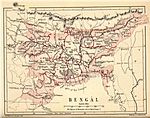 |
| Ancient Kingdoms |
| Classical Dynasties |
| Islamic Bengal |
| Colonial Bengal |
| Post-partition era |
Modern period
|
| Related |
| Part of a series on |
| Bengalis |
|---|
 |
| Bengali history |
| Bengali homeland |
Bengali people
|
| Bengali culture |
| Bengali symbols |
| Bengali nationalism |
This is a list of rulers of Bengal. For much of its history, Bengal was split up into several independent kingdoms, completely unifying only several times. In ancient times, Bengal consisted of the kingdoms of Pundra, Suhma, Vanga, Samatata and Harikela.
In the 4th century BCE, during the reign of the Nanda Empire, the powerful rulers of Gangaridai sent their forces with the war elephants which led the withdrawal of Alexander the Great from the Indian subcontinent.
With the rise of Gopala in 750 AD, Bengal was united once more under the Buddhist and Shaivite Pala Empire. The Pala period is considered as one of golden eras of Bengali history as it brought stability and prosperity to Bengal after centuries of Civil War, created outstanding works of art and architecture, proto-Bengali language develop under them including its first literary work, the Charyapada and so on. Until the 12th century than being succeeded by the Buddhist and Hindu Chandra dynasty, Sena dynasty and Deva dynasty. The rule of deva dynasty was a period of peace, prosperity and creative excellence and may be designed as "golden age" After them, Bengal was ruled by the Hindu Maharajas of kingdoms such as Chandradwip and Cooch Behar.
In the early 13th century, Muhammad bin Bakhtiyar Khalji conquered Western and part of Northern Bengal, and established the first Muslim kingdom in Bengal. The Islamic Mamluk Sultanate, the Khalji dynasty, the Turko-Indian Tughlaq dynasty, the Sayyid dynasty and the Lodi dynasty ruled Bengal for over 320 years. Notable was Malik Altunia's reign with his wife Razia Sultana, the only female sovereign ruler.
Following Delhi Sultanate's reign, the Bengal Sultanate, a major trading nation in the world, was founded by Shamsuddin Ilyas Shah, and ruled by the Ilyas Shahi dynasty, succeeded by the Hussain Shahi dynasty founded by Alauddin Husain Shah, which saw the extension of the sultanate to the port of Chittagong, witnessing the arrival of the earliest Portuguese merchants.
Ancient Bengal
Main article: History of BengalAncient geopolitical divisions
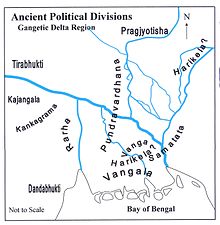
| Ancient region | Modern region |
|---|---|
| Pundravardhana | Rajshahi Division and Rangpur Division in Bangladesh; Malda division of West Bengal in India |
| Vanga | Khulna Division and Barisal Division in Bangladesh; West of the Padma river. |
| Tirabhukti | Mithila area of India and Nepal |
| Gauda | Modern Malda and Murshidabad districts of West Bengal, India |
| Suhma | Burdwan division, Medinipur division and Presidency division of West Bengal in India |
| Rarh | Corresponds to the modern Bardhaman, Bankura, Hooghly and Nadia districts of West Bengal in India |
| Samatata | Dhaka Division, Barisal Division and Chittagong Division in Bangladesh |
| Harikela | Sylhet Division, Chittagong Division, Dhaka Division and Barisal Division in Bangladesh |
The founders of Angas, Vangas, Kalingas, Pundras, Odras and Suhmas shared a common ancestry. They were all adopted sons of a king named Bali, born by a sage named Gautama Dirghatamas, who lived in Magadha close to the city of Girivraja.
- Bengal from c. 1100 to c. 600 BCE

- Bengal from c. 600 to c. 350 BCE

- Bengal in c. 350 BCE
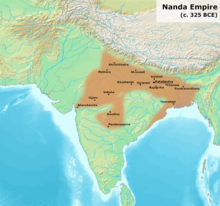
Anga kingdom (c. 1100–530 BCE)
Main article: Anga| The neutrality of this section is disputed. Relevant discussion may be found on the talk page. Please do not remove this message until conditions to do so are met. (November 2023) (Learn how and when to remove this message) |
The earliest mention occurs in the Atharvaveda (V.22.14) where they are listed alongside the Magadhas, Gandharis and the Mujavatas. Anga was annexed by Magadha in the time of Bimbisara. This was the one and only conquest of Bimbisara.
Known Anga rulers include:
- Maharaj Anga – (founder of the kingdom and son of King Bali)
- Romapada
- Brihadratha
- Angaraj Karna
- Vrishaketu – (son of Karna)
- Tamralipta
- Lomapada
- Chitraratha
- Vrihadratha
- Vasuhoma
- Dhatarattha
- Dhadivahana
- Brahmadatta – (last king of Anga kingdom)
Vanga kingdom (c. 1100–340 BCE)
Main article: Vanga KingdomVanga was an ancient kingdom and geopolitical division on the Ganges delta. It was located in southern Bengal, with the core region including present-day southwestern Bangladesh and southern West Bengal (India).
Known Vanga rulers are:
- Samudrasena
- Chadrasena
- Karna
- Bhagabhatta
Pundra kingdom (c. 1100–340 BCE)
Main article: PundravardhanaPundravardhana or Pundra Kingdom, was an ancient kingdom, that included parts of present-day Rajshahi and Rangpur Divisions of Bangladesh as well as the West Dinajpur district of West Bengal in India.
Known Pundra rulers are:
Suhma kingdom (c. 1100–340 BCE)
Main article: Suhma kingdomSuhma kingdom was an ancient state during the Vedic period on the eastern part of the Bengal.This kingdom was mentioned in the epic Mahabharata along with its neighbouring kingdom Prasuhma.
Videha dynasty of Mithila (Tirabhukti) (c. 1100–700 BCE)
Main articles: Videha and Mithila (region) See also: History of Mithila RegionTirabhukti or Mithila region is bounded by the Mahananda River in the east, the Ganges in the south, the Gandaki River in the west and by the foothills of the Himalayas in the north.
Mithila region firstly ruled by Videha dynasty. There were 52 Janaka (kings) ruled Videha dynasty of Mithila-
- Mithi (founder of Mithila and the first Janaka)
- Udavasu
- Nandivardhana
- Suketu
- Devarata
- Brihadvrata
- Mahavira
- Sudhriti
- Dristaketu
- Haryasva
- Maru
- Pratindhaka
- Kritiratha
- Devamidha
- Vibhuta
- Mahidhrata
- Kirtirata
- Mahorama
- Swarnorama
- Hrisvaroma
- Seeradhwaja
- Bhaanumaan
- Shatadyumn
- Shuchi
- Oorjnaamaa
- Kriti
- Anjan
- Kurujit
- Arishtnemi
- Shrutaayu
- Supaarshwa
- Srinjaya
- Kshemaavee
- Anenaa
- Bhaumarath
- Satyarath
- Upagu
- Upagupt
- Swaagat
- Swaanand
- Suvarchaa
- Supaarshwa
- Subhaash
- Sushrut
- Jaya
- Vijaya
- Rit
- Sunaya
- Veetahavya
- Dhriti
- Bahulaashwa
- Kriti (last King of Videha or Janaka dynasty, Kirti Janak was atrocious ruler who lost control over his subjects. He was dethroned by public under leadership of Acharyas (Learned Men).
During this period of fall of Videha dynasty, the famous republic of Licchavi was rising in Vaishali and Mithila region came under control of Licchavi clan of Vajji confederacy in around eighth century BCE.
Gangaridai kingdom (c. 350–100 BCE)
Main article: GangaridaiGangaridae is a term used by the ancient Greco-Roman writers to describe a people or a geographical region of the ancient Indian subcontinent. Some of these writers state that Alexander the Great withdrew from the Indian subcontinent because of the strong war elephant force of the Gangaridai. However, the geographical region was annexed and governed by the Nanda Empire at the time.
A number of modern scholars locate Gangaridai in the Ganges Delta of the Bengal region, although alternative theories also exist. Gange or Ganges, the capital of the Gangaridai (according to Ptolemy), has been identified with several sites in the region, including Chandraketugarh and Wari-Bateshwar.
Magadha dynasties of Bengal
Main article: Magadha
Brihadratha dynasty (c. 1700–682 BCE)
Main article: Brihadratha dynasty- Rulers-
| Ruler | Reign (BCE) |
|---|---|
| Brihadratha | – BCE |
| Jarasandha | – BCE |
| Sahadeva of Magadha | – BCE |
| Somadhi | 1661–1603 BCE |
| Srutasravas | 1603–1539 BCE |
| Ayutayus | 1539–1503 BCE |
| Niramitra | 1503–1463 BCE |
| Sukshatra | 1463–1405 BCE |
| Brihatkarman | 1405–1382 BCE |
| Senajit | 1382–1332 BCE |
| Srutanjaya | 1332–1292 BCE |
| Vipra | 1292–1257 BCE |
| Suchi | 1257–1199 BCE |
| Kshemya | 1199–1171 BCE |
| Subrata | 1171–1107 BCE |
| Dharma | 1107–1043 BCE |
| Susuma | 1043–970 BCE |
| Dridhasena | 970–912 BCE |
| Sumati | 912–879 BCE |
| Subala | 879–857 BCE |
| Sunita | 857–817 BCE |
| Satyajit | 817–767 BCE |
| Viswajit | 767–732 BCE |
| Ripunjaya | 732–682 BCE |
(Ripunjaya was the last ruler of dynasty, dethorned by Pradyota in 682 BCE)
Pradyota dynasty (c. 682–544 BCE)
Main article: Pradyota dynasty- Rulers-
| Ruler | Reign (BCE) | Period |
|---|---|---|
| Pradyota Mahasena | 682–659 BCE | 23 |
| Palaka | 659–635 BCE | 24 |
| Visakhayupa | 635–585 BCE | 50 |
| Ajaka | 585–564 BCE | 21 |
| Varttivarddhana | 564–544 BCE | 20 |
(Varttivarddhana was last ruler of dynasty dethroned by Bimbisara in 544 BCE)
Haryanka dynasty (c. 544–413 BCE)
Main article: Haryanka dynasty- Rulers-
| Ruler | Reign (BCE) |
|---|---|
| Bimbisara | 544–491 BCE |
| Ajatashatru | 491–461 BCE |
| Udayin | 461–428 BCE |
| Anirudha | 428–419 BCE |
| Munda | 419–417 BCE |
| Darshaka | 417–415 BCE |
| Nāgadāsaka | 415–413 BCE |
(Nāgadāsaka was last ruler of dynasty overthrowed by Shishunaga in 413 BCE)
Shishunaga dynasty (c. 413–345 BCE)
Main article: Shaishunaga dynasty- Rulers-
| Ruler | Reign (BCE) |
|---|---|
| Shishunaga | 413–395 BCE |
| Kalashoka | 395–377 BCE |
| Kshemadharman | 377–365 BCE |
| Kshatraujas | 365–355 BCE |
| Nandivardhana | 355–349 BCE |
| Mahanandin | 349–345 BCE |
(Mahanandin lost his empire by his illegitimate son Mahapadma Nanda in 345 BCE)
Nanda Empire (c. 345–322 BCE)
Main article: Nanda Empire See also: Conquest of the Nanda Empire- Rulers-
| Ruler | Reign (BCE) |
|---|---|
| Mahapadma Nanda | 345–340 BCE |
| Pandukananda | 340–339 BCE |
| Pandugatinanda | 339–338 BCE |
| Bhutapalananda | 338–337 BCE |
| Rashtrapalananada | 337–336 BCE |
| Govishanakananda | 336–335 BCE |
| Dashasiddhakananda | 335–334 BCE |
| Kaivartananda | 334–329 BCE |
| Dhana Nanda | 329–321 BCE |
(Dhana Nanda lost his empire to Chandragupta Maurya after being defeated by him in 322 BCE)
Maurya Empire (c. 322–184 BCE)
Main article: Maurya Empire- Rulers-
| Ruler | Reign | Notes | |
|---|---|---|---|
| Chandragupta Maurya | 322–297 BCE | Founder of first Indian united empire. | |
| Bindusara Amitraghata | 297–273 BCE | Known for his foreign diplomacy and crushed of Vidarbh revolt. | |
| Ashoka | 268–232 BCE | Greatest emperor of dynasty. His son Kunala was blinded and died before his father. Ashoka was succeeded by his grandson. Also known for Kalinga war victory. | |
| Dasharatha Maurya | 232–224 BCE | Grandson of Ashoka. | |
| Samprati | 224–215 BCE | Brother of Dasharatha. | |
| Shalishuka | 215–202 BCE | ||
| Devavarman | 202–195 BCE | ||
| Shatadhanvan | 195–187 BCE | Mauryan Empire had shrunk by the time of his reign | |
| Brihadratha | 187–184 BCE | Assassinated by his Commander-in-chief Pushyamitra Shunga in 185 BCE. | |
(Brihadratha was the last ruler of dynasty, dethroned by Pushyamitra Shunga in 185 BCE)
Shunga Empire (c. 185–73 BCE)
Main article: Shunga Empire- Rulers-
| Ruler | Reign (BCE) |
|---|---|
| Pushyamitra Shunga | 185–149 BCE |
| Agnimitra | 149–141 BCE |
| Vasujyeshtha | 141–131 BCE |
| Vasumitra | 131–124 BCE |
| Bhadraka | 124–122 BCE |
| Pulindaka | 122–119 BCE |
| Ghosha | 119–108 BCE |
| Vajramitra | 108–94 BCE |
| Bhagabhadra | 94–83 BCE |
| Devabhuti | 83–73 BCE |
(Devabhuti was the last ruler of dynasty dethroned by, dethroned Vasudeva Kanva in 73 BCE)
Kanva dynasty (c. 73–28 BCE)
Main article: Kanva dynasty- Rulers-
| Ruler | Reign | Period |
|---|---|---|
| Vasudeva Kanva | 73–64 BCE | 9 |
| Bhumimitra | 64–50 BCE | 14 |
| Narayana | 50–38 BCE | 12 |
| Susarman | 38–28 BCE | 10 |
(Susarman was the last ruler of dynasty, dethroned by Simuka of Satavahana Empire)
Classical Era
Chandra dynasty (c. 202–1050 CE)
Main articles: Chandra dynasty and HarikelaThe Chandra Kingdom was a Kayastha kingdom, which ruled the Samatata region of Bengal, as well as northern Arakan. Later it was a neighbor to the Pala Empire to the north. Rulers of Chandra kingdom were followers of Hinduism.
- Rulers-
| # | King | Period | Reign (CE) |
|---|---|---|---|
| 1 | Chandrodaya | 27 | 202–229 |
| 2 | Annaveta | 5 | 229–234 |
| 3 | Chandranveta | 77 | 234–311 |
| 4 | Rimbhiappa | 23 | 311–334 |
| 5 | Kuverami (Queen) | 7 | 334–341 |
| 6 | Umavira | 20 | 341–361 |
| 7 | Jugna | 7 | 361–368 |
| 8 | Lanki | 2 | 368–370 |
| 9 | Dvenchandra | 55 | 370–425 |
| 10 | Rajachandra | 20 | 425–445 |
| 11 | Kalachandra | 9 | 445–454 |
| 12 | Devachandra | 22 | 454–476 |
| 13 | Yajnachandra | 7 | 476–483 |
| 14 | Chandrabandu | 6 | 483–489 |
| 15 | Bhumichandra | 7 | 489–496 |
| 16 | Bhutichandra | 24 | 496–520 |
| 17 | Nitichandra | 55 | 520–575 |
| 18 | Virachandra | 3 | 575–578 |
| 19 | Pritichandra | 12 | 578–590 |
| 20 | Prithvichandra | 7 | 590–597 |
| 21 | Dhirtichandra | 3 | 597–600 |
| 22 | Mahavira | 12 | 600–612 |
| 23 | Virayajap | 12 | 612–624 |
| 24 | Sevinren | 12 | 624–636 |
| 25 | Dharmasura | 13 | 636–649 |
| 26 | Vajrashakti | 16 | 649–665 |
| 27 | Dharmavijaya | 36 | 665–701 |
| 28 | Narendravijaya | 2 yr 9 months | 701–703 |
| 29 | Dharmachandra | 16 | 703–720 |
| 30 | Anandachandra | 9+ | 720–729+ |
| Harikela dynasty | |||
| 1 | Traillokyachandra | 30 | 900–930 |
| 2 | Srichandra | 45 | 930–975 |
| 3 | Kalyanachandra | 25 | 975–1000 |
| 4 | Ladahachandra | 20 | 1000–1020 |
| 5 | Govindachandra | 30 | 1020–1050 |
Gupta Empire (c. 240–550 CE)
Main article: Gupta Empire- Rulers-
- Sri-Gupta I (240–280), founder of dynasty
- Ghatotkacha (280–319)
- Chandra Gupta I (320–335)
- Samudra Gupta (335–380)
- Rama Gupta (6 Months)
- Chandra Gupta II (Chandragupta Vikramaditya) (380–413/415)
- Kumara Gupta I (415–455)
- Skanda Gupta (455–467)
- Puru Gupta(467–473)
- Kumara Gupta II (473–476)
- Buddha Gupta (476–495)
- Narasimha Gupta(495–550)
- Kumara Gupta III (500–540)
- Vishnugupta (540–550), last imperial Gupta ruler.
Jaintia kingdom (c. 525–1835 CE)
Main article: Jaintia KingdomOld dynasty rulers
- Urmi Rani (?–550)
- Krishak Pator (550–570)
- Hatak (570–600)
- Guhak (600–630)
Partitioned Jaintia rulers
- Jayanta (630–660)
- Joymalla (660–?)
- Mahabal (?)
- Bancharu (?–1100)
- Kamadeva (1100–1120)
- Bhimbal (1120)
Brahmin dynasty rulers
- Kedareshwar Rai (1120–1130)
- Dhaneshwar Rai (1130–1150)
- Kandarpa Rai (1150–1170)
- Manik Rai (1170–1193)
- Jayanta Rai (1193–1210)
- Jayanti Devi
- Bara Gossain
New dynasty rulers
- Prabhat Ray Syiem Sutnga (1500–1516)
- Majha Gosain Syiem Sutnga (1516–1532)
- Burha Parbat Ray Syiem Sutnga (1532–1548)
- Bar Gosain Syiem Sutnga I (1548–1564)
- Bijay Manik Syiem Sutnga (1564–1580)
- Pratap Ray Syiem Sutnga (1580–1596)
- Dhan Manik Syiem Sutnga (1596–1612)
- Jasa Manik Syiem Sutnga (1612–1625)
- Sundar Ray Syiem Sutnga (1625–1636)
- Chota Parbat Ray Syiem Sutnga (1636–1647)
- Jasamanta Ray Syiem Sutnga (1647–1660)
- Ban Singh Syiem Sutnga (1660–1669)
- Pratap Singh Syiem Sutnga (1669–1678)
- Lakshmi Narayan Syiem Sutnga (1678–1694)
- Ram Singh Syiem Sutnga I (1694–1708)
- Jay Narayan Syiem Sutnga (1708–1731)
- Bar Gosain Syiem Sutnga II (1731–1770)
- Chattra Singh Syiem Sutnga (1770–1780)
- Yatra Narayan Syiem Sutnga (1780-1785)
- Bijay Narayan Syiem Sutnga (1785–1786)
- Lakshmi Singh Syiem Sutnga (1786-1790)
- Ram Singh Syiem Sutnga II (1790–1832)
- Rajendra Singh Syiem Sutnga (1832–1835)
Gauda kingdom (c. 550–626 CE)
Main article: Gauda Kingdom- Rulers-
- Early Gaunda rulers are unknown
- Shashanka (590–625), first recorded independent Hindu king of Bengal, created the first unified political entity in Bengal.
- Manava (625–626), ruled for 8 months before being conquered by Harshavardana and Bhaskarvarmana in 626 CE.
Pushyabhuti (Vardhana) Empire (c. 606–647 CE)
Main article: Pushyabhuti dynasty- Rulers of Bengal-
- Harshavardhana (606–647), unified Northern India and ruled it for over 40 years, he was the last non-Muslim emperor to rule a unified Northern India
Khadga dynasty (c. 625–730 CE)
Main article: Khadga dynasty- Rulers-
| Titular Name | Reign | Notes |
|---|---|---|
| Khadgodyama | 625-640 | Father of Jatakhadga |
| Jatakhadga | 640-658 | Father of Devakhadga |
| Devakhadga | 658-673 | Queen Prabhavati |
| Rajabhatta | 673-707 | Son of Devakhadga |
| Balabhata | 707-716 | Son of Devakhadga |
| Udirnakhadga | ?? |
Bhadra dynasty (6th to 7th century)
Main article: Bhadra dynastyThe Bhadra dynasty was a Bengali Hindu royal house of Brahmin origin, their rule flourished during the first half of the 7th century, though little is known about their history. The kings of the dynasty bore names with the suffix "Bhadra".
- Known rulers are-
- Narayanabhadra
- Jyeshthabhadra
Mallabhum kingdom (c. 694–1147 CE)
Main article: Mallabhum- Rulers-
| Name of the king | Reign | Notes |
|---|---|---|
| Adi Malla | 694–710 | |
| Jay Malla | 710–720 | |
| Benu Malla | 720–733 | |
| Kinu Malla | 733–742 | |
| Indra Malla | 742–757 | |
| Kanu Malla | 757–764 | |
| Dha (Jhau) Malla | 764–775 | |
| Shur Malla | 775–795 | |
| Kanak Malla | 795–807 | |
| Kandarpa Malla | 807–828 | |
| Sanatan Malla | 828–841 | |
| Kharga Malla | 841–862 | |
| Durjan (Durjay) Malla | 862–906 | |
| Yadav Malla | 906–919 | |
| Jagannath Malla | 919–931 | |
| Birat Malla | 931–946 | |
| Mahadev Malla | 946–977 | |
| Durgadas Malla | 977–994 | |
| Jagat Malla | 994–1007 | |
| Ananta Malla | 1007–1015 | |
| Rup Malla | 1015–1029 | |
| Sundar Malla | 1029–1053 | |
| Kumud Malla | 1053–1074 | |
| Krishna Malla | 1074–1084 | |
| Rup II (Jhap) Malla | 1084–1097 | |
| Prakash Malla | 1097–1102 | |
| Pratap Malla | 1102–1113 | |
| Sindur Malla | 1113–1129 | |
| Sukhomoy(Shuk) Malla | 1129–1142 | |
| Banamali Malla | 1142–1156 | |
| Yadu/Jadu Malla | 1156–1167 | |
| Jiban Malla | 1167–1185 | |
| Ram Malla | 1185–1209 | |
| Gobinda Malla | 1209–1240 | |
| Bhim Malla | 1240–1263 | |
| Katar(Khattar) Malla | 1263–1295 | |
| Prithwi Malla | 1295 -1319 | |
| Tapa Malla | 1319–1334 | |
| Dinabandhu Malla | 1334–1345 | |
| Kinu/Kanu II Malla | 1345–1358 | |
| Shur Malla II | 1358–1370 | |
| Shiv Singh Malla | 1370–1407 | |
| Madan Malla | 1407–1420 | |
| Durjan II (Durjay) Malla | 1420–1437 | |
| Uday Malla | 1437–1460 | |
| Chandra Malla | 1460–1501 | |
| Bir Malla | 1501–1554 | |
| Dhari Malla | 1554–1565 | |
| Hambir Malla Dev (Bir Hambir) | 1565–1620 | |
| Dhari Hambir Malla Dev | 1620–1626 | |
| Raghunath Singha Dev | 1626–1656 | |
| Bir Singha Dev | 1656–1682 | |
| Durjan Singha Dev | 1682–1702 | |
| Raghunath Singha Dev II | 1702–1712 | |
| Gopal Singha Dev | 1712–1748 | |
| Chaitanya Singha Dev | 1748–1801 | |
| Madhav Singha Dev | 1801–1809 | |
| Gopal Singha Dev II | 1809–1876 | |
| Ramkrishna Singha Dev | 1876–1885 | |
| Dwhaja Moni Devi | 1885–1889 | |
| Nilmoni Singha Dev | 1889–1903 | |
| Churamoni Devi (Regency) | 1903–1930 | |
| Kalipada Singha Thakur | 1930–1947 |
Post-Classical era
Pala Empire (c. 750–1161 CE)
Most of the Pala inscriptions mention only the regnal year as the date of issue, without any well-known calendar era. Because of this, the chronology of the Pala kings is hard to determine. Based on their different interpretations of the various epigraphs and historical records, different historians estimate the Pala chronology as follows:
| RC Majumdar (1971) | AM Chowdhury (1967) | BP Sinha (1977) | DC Sircar (1975–76) | D. K. Ganguly (1994) | |
|---|---|---|---|---|---|
| Gopala I | 750–770 | 756–781 | 755–783 | 750–775 | 750–774 |
| Dharmapala | 770–810 | 781–821 | 783–820 | 775–812 | 774–806 |
| Devapala | 810–c. 850 | 821–861 | 820–860 | 812–850 | 806–845 |
| Mahendrapala | NA (Mahendrapala's existence was conclusively established through a copper-plate charter discovered later.) | 845–860 | |||
| Shurapala I | Deemed to be alternate name of Vigrahapala I | 850–858 | 860–872 | ||
| Gopala II | NA (copper-plate charter discovered in 1995. Text of inscription published in 2009.) | ||||
| Vigrahapala I | 850–853 | 861–866 | 860–865 | 858–60 | 872–873 |
| Narayanapala | 854–908 | 866–920 | 865–920 | 860–917 | 873–927 |
| Rajyapala | 908–940 | 920–952 | 920–952 | 917–952 | 927–959 |
| Gopala III | 940–957 | 952–969 | 952–967 | 952–972 | 959–976 |
| Vigrahapala II | 960–c. 986 | 969–995 | 967–980 | 972–977 | 976–977 |
| Mahipala I | 988–c. 1036 | 995–1043 | 980–1035 | 977–1027 | 977–1027 |
| Nayapala | 1038–1053 | 1043–1058 | 1035–1050 | 1027–1043 | 1027–1043 |
| Vigrahapala III | 1054–1072 | 1058–1075 | 1050–1076 | 1043–1070 | 1043–1070 |
| Mahipala II | 1072–1075 | 1075–1080 | 1076–1078/9 | 1070–1071 | 1070–1071 |
| Shurapala II | 1075–1077 | 1080–1082 | 1071–1072 | 1071–1072 | |
| Ramapala | 1077–1130 | 1082–1124 | 1078/9–1132 | 1072–1126 | 1072–1126 |
| Kumarapala | 1130–1140 | 1124–1129 | 1132–1136 | 1126–1128 | 1126–1128 |
| Gopala IV | 1140–1144 | 1129–1143 | 1136–1144 | 1128–1143 | 1128–1143 |
| Madanapala | 1144–1162 | 1143–1162 | 1144–1161/62 | 1143–1161 | 1143–1161 |
| Govindapala | 1158–1162 | NA | 1162–1176 or 1158–1162 | 1161–1165 | 1161–1165 |
| Palapala | NA | NA | NA | 1165–1199 | 1165–1200 |
Sena dynasty (c. 1070–1230 CE)
Main article: Sena dynastySena dynasty ruled southwestern Bengal from 1070 and ruled East Bengal until 1230. Vijaya Sena conquered entire Bengal by 1154 CE.
- Rulers-
- Hemanta Sena (1070–1096)
- Vijaya Sena (1096–1159)
- Ballala Sena (1159–1179)
- Lakshmana Sena (1179–1206)
- Vishvarupa Sena (1206–1225)
- Keshava Sena (1225–1230)
Deva dynasty (c. 1150–1294 CE)
Main article: Deva dynasty- List of rulers is disputed-
- Purushottamadeva
- Madhusudanadeva
- Vasudeva
- Shantideva
- Viradeva
- Anandadeva
- Bhavadeva
- Damodaradeva (1231–1243)
- Dasharathadeva (1243–1281)
- Vikramadityadeva (1281–1294)
Delhi Sultanate period
Khalji dynasty
The Khalji dynasty of Bengal (c.1204–27) were initially representatives of the Ghurid Empire, later becoming independent, although at times being subordinate to the Delhi Sultanate.
| Name | Reign | Notes |
|---|---|---|
| Muhammad bin Bakhtiyar Khalji | c.1204–1206 | Began the Khalji dynasty in Bengal |
| Muhammad Shiran Khalji | 1206–1208 | |
| Husamuddin Iwaz Khalji | 1208–1210 | |
| Ali Mardan Khalji | 1210–1212 | |
| Ghiyasuddin Iwaz Shah | 1212–1227 | Second term, killed for gaining independence from Sultan of Delhi Iltutmish |
| Alauddin Daulat Shah Khalji | 1229–1230 | |
| Balka Khalji | 1230–1231 | Last Khalji ruler |
Governors of Bengal under Mamluk dynasty (1227–1287)
Governors of Bengal under the Mamluk dynasty of the Delhi Sultanate.
| Name | Reign | Notes |
|---|---|---|
| Nasiruddin Mahmud | 1227–1229 | Appointed by his father Sultan Iltutmish of Delhi |
| Alauddin Jani | 1232–1233 | |
| Saifuddin Aibak | 1233–1236 | |
| Awar Khan Aibak | 1236 | Usurper |
| Tughral Tughan Khan | 1236–1246 | Restored Mamluk governor |
| Tughlaq Tamar Khan | 1246–1247 | |
| Jalaluddin Masud Jani | 1247–1251 | |
| Malik Ikhtiyaruddin Iuzbak | 1251–1257 | Claimed independence. |
| Ijjauddin Balban Iuzbaki | 1257–1259 | |
| Tatar Khan | 1259–1268 | Claimed independence. |
| Sher Khan | 1268–1272 | |
| Amin Khan | 1272–1272 | |
| Tughral Tughan Khan | 1272–1281 | Second term as Mughisuddin Tughral |
| Nasiruddin Bughra Khan | 1281–1287 | Declared independence and founded the Balban dynasty |
House of Balban
The House of Balban (c.1287–1324) came about as a result of Mamluk governor Nasiruddin Bughra Khan declaring independence.
| Name | Reign | Notes |
|---|---|---|
| Nasiruddin Bughra Khan | 1287–1291 | Declared independence from Delhi Sultanate |
| Rukunuddin Kaikaus | 1291–1300 | First Muslim ruler to conquer Satgaon kingdom, expanding Lakhnauti. |
| Shamsuddin Firoz Shah | 1300–1322 | First Muslim ruler to conquer Sonargaon, Mymensingh and Srihatta. Completed Kaikaus' Conquest of Satgaon. |
| Ghiyasuddin Bahadur Shah | 1322–1324 | Lost independence of Bengal to Delhi Sultan Ghiyasuddin Tughlaq. |
Governors of Bengal under Tughlaq dynasty (1324–1338)
| Name | Region | Reign | Notes |
|---|---|---|---|
| Ghiyasuddin Bahadur Shah | Sonargaon | 1324–1328 | Appointed as governor by Sultan of Delhi Muhammad bin Tughluq, but later declared independence |
| Bahram Khan | Sonargaon | 1328–1338 | |
| Qadar Khan | Lakhnauti | 1328–1336 | |
| Mukhlis | Lakhnauti | 1336–1339 | |
| Azam Khan | Satgaon | 1324–1328 | |
| Izzuddin Yahya | Satgaon | 1328–1338 |
Bengal Sultanate era
Independent Sultans of Bengal during Tughlaq dynasty (1338–1352)
| Name | Region | Reign | Notes |
|---|---|---|---|
| Fakhruddin Mubarak Shah | Sonargaon | 1338–1349 | First independent ruler of Sonargaon and the Founder of mubarak shahi dynasty |
| Ikhtiyaruddin Ghazi Shah the last Sultan of mubarak shahi dynasty | Sonargaon | 1349–1352 | |
| Ilyas Shah | Satgaon | 1339–1342 | |
| Alauddin Ali Shah | Lakhnauti | 1339–1342 | |
| Ilyas Shah | Lakhnauti and Satgaon | 1342–1352 |
Ilyas Shahi dynasty (1352–1414)
Main article: Ilyas Shahi dynasty| Name | Reign | Notes |
|---|---|---|
| Shamsuddin Ilyas Shah | 1352–1358 | Became the first sole ruler of whole Bengal comprising Sonargaon, Satgaon and Lakhnauti. |
| Sikandar Shah | 1358–1390 | Killed in battle with his son and successor, Ghiyasuddin Azam Shah |
| Ghiyasuddin Azam Shah | 1390–1411 | |
| Saifuddin Hamza Shah | 1411–1412 | |
| Shihabuddin Bayazid Shah | 1412–1414 |
House of Raja Ganesha (1414–1435)
| Name | Reign | Notes |
|---|---|---|
| Raja Ganesha | 1414–1415 | |
| Jalaluddin Muhammad Shah | 1415–1416 | Son of Raja Ganesha and converted into Islam |
| Raja Ganesha | 1416–1418 | Second Phase |
| Jalaluddin Muhammad Shah | 1418–1433 | Second Phase |
| Shamsuddin Ahmad Shah | 1433–1435 |
Restored Ilyas Shahi dynasty (1435–1487)
| Name | Reign | Notes |
|---|---|---|
| Nasiruddin Mahmud Shah | 1435–1459 | |
| Rukunuddin Barbak Shah | 1459–1474 | Son of Mahmud Shah |
| Shamsuddin Yusuf Shah | 1474–1481 | Son of Barbak Shah |
| Nuruddin Sikandar Shah | 1481 | Son of Mahmud Shah |
| Jalaluddin Fateh Shah | 1481–1487 | Son of Mahmud Shah |
Habshi rule (1487–1494)
| Name | Reign | Notes |
|---|---|---|
| Shahzada Barbak | 1487 | |
| Saifuddin Firuz Shah | 1487–1489 | |
| Mahmud Shah II | 1489–1490 | |
| Shamsuddin Muzaffar Shah | 1490–1494 |
Hussain Shahi dynasty (1494–1538)
| Name | Reign | Notes |
|---|---|---|
| Alauddin Hussain Shah | 1494–1518 | considered greatest of all sultans of Bengal for bringing cultural renaissance during his reign. |
| Nasiruddin Nasrat Shah | 1518–1533 | |
| Alauddin Firuz Shah | 1533 | |
| Ghiyasuddin Mahmud Shah | 1533–1538 |
Governors of Bengal under Sur Empire (1532–1556)
| Name | Reign | Notes |
|---|---|---|
| Sher Shah Suri | 1532–1538 | Defeated Mughals and became the ruler of Delhi in 1540. |
| Khidr Khan | 1538–1541 | |
| Qazi Fazilat | 1541–1545 | |
| Muhammad Khan Sur | 1545–1554 | |
| Shahbaz Khan | 1555 |
Muhammad Shah dynasty (1554–1564)
| Name | Reign | Notes |
|---|---|---|
| Muhammad Khan Sur | 1554–1555 | Declared independence and styled himself as Shamsuddin Muhammad Shah |
| Khizr Khan Suri | 1555–1561 | |
| Ghiyasuddin Jalal Shah | 1561–1563 | |
| Ghiyasuddin Bahadur Shah III | 1563–1564 |
Karrani dynasty (1564–1576)
| Name | Reign | Notes |
|---|---|---|
| Taj Khan Karrani | 1564–1566 | |
| Sulaiman Khan Karrani | 1566–1572 | |
| Bayazid Khan Karrani | 1572 | |
| Daud Khan Karrani | 1572–1576 |
• Isa Khan
• Fazal Ghazi
• Bahadur Ghazi
• Khwaja Usman Khan Lohani
• Bayezid Karrani
• 'Pratapaditya'
• Bir Hambir
• Kedar Roy
• Chad Ray
• Mukundaram Roy
Mughal Subahdars of Bengal Subah (1574–1717)
During the reign of Akbar
| Name | Reign | Notes |
|---|---|---|
| Munim Khan | 25 September 1574–23 October 1575 | Khan-i-Khanan |
| Hussain Quli Khan | 23 October 1575–19 December 1578 | |
| Muzaffar Khan Turbati | 1579–1582 | |
| Mirza Aziz Koka | 1582–1583 | |
| Wazir Khan Tajik | 1583–1583 | |
| Shahbaz Khan Kamboh | 1583–1585 | |
| Sadiq Khan | 1585–1586 | |
| Shahbaz Khan Kamboh | 1586–1588 | |
| Sa'id Khan | 1588–1594 | |
| Raja Man Singh I | 1597 – 1606 |
During the reign of Jahangir
| Name | Reign | Notes |
|---|---|---|
| Qutubuddin Koka | 2 Sep 1606 – 1607 | killed in a battle against Sher Afghan. (Local history of Burdwan, West Bengal, India says that Qutub-ud-din Kokah died in a battle against Ali Quli Istajlu alias Sher Afgan in 1610 CE. The tomb where both of them were buried is presently under the surveillance of Archaeological Survey of India.) |
| Jahangir Quli Beg | 1607–1608 | In early life, a slave of Akbar's brother, Mirza Muhammad Hakim |
| Islam Khan Chishti | 1608–1613 | first governor to transfer the Bengal capital to Dhaka in April 1612 |
| Qasim Khan Chishti | 1613–1617 | younger brother of Islam Khan Chishti |
| Ibrahim Khan Fath-i-Jang | 1617–1624 | died in an attack by Prince Shahjahan |
| Darab Khan | 1624–1625 | while Shahjahan occupied Bengal. Killed by Mahabbat Khan. |
| Mahabat Khan | 1625–1626 | |
| Mukarram Khan | 1626–1627 | |
| Fidai Khan | 1627–1628 |
During the reign of Shah Jahan
| Name | Reign | Notes |
|---|---|---|
| Qasim Khan Juvayni | 1628–1632 | |
| Mir Muhammad Baqir | 1632–1635 | Known as Azam Khan |
| Mir Abdus Salam | 1635–1639 | Known as Islam Khan Mashadi |
| Prince Shah Shuja | 1639–1647 again 1652–1660 |
During the reign of Aurangzeb
| Name | Reign | Notes |
|---|---|---|
| Mir Jumla II | 1660–1663 | |
| Shaista Khan | 1664–1678 | |
| Azam Khan Koka | 1678–1678 | Known as Fidai Khan II |
| Prince Muhammad Azam | 20 July 1678 – 6 October 1679 | |
| Shaista Khan | 1680–1688 | |
| Ibrahim Khan II | 1689–1697 | |
| Prince Azim-us-Shan | 1697–1712 |
Medieval Hindu dynasties of Bengal
See also: List of Hindu empires and dynastiesKoch dynasty (c. 1515–1949 CE)
Main article: Koch dynastyRulers of undivided Koch dynasty (c. 1515–1586 CE)
- Biswa Singha (1515–1540 CE)
- Nara Narayan (1540–1586 CE)
Rulers of Koch Behar (c. 1586 – 1949)
Further information: Cooch Behar State- Lakshmi Narayan
- Bir Narayan
- Pran Narayan
- Basudev Narayan
- Mahindra Narayan
- Roop Narayan
- Upendra Narayan
- Devendra Narayan
- Dhairjendra Narayan
- Rajendra Narayan
- Dharendra Narayan
- Harendra Narayan
- Shivendra Narayan
- Narendra Narayan
- Nripendra Narayan
- Rajendra Narayan II
- Jitendra Narayan (father of Gayatri Devi)
- Jagaddipendra Narayan (ruled till 1949)
Kingdom of Bhurshut (c. 16th–18th century)
Main article: Bhurshut- Maharaja Shivanarayan
- Maharaja Rudranarayan, Maharaja (16th century)
- Bhavashankari, Maharani (16th century)
- Pratapnarayan, Maharaja (17th century)
- Naranarayan, Maharaja (17th century)
- Lakshminarayan, Maharaja (c. 1695–1712)
Kingdom of Chandradweep or Basu Dynasty
Chandradweep ruled by
- Raja Paramananda Basu
- Raja Jagganath Basu
- Kandarpanarayan Basu ( 1582-1598)
- Ramchandra Basu
- Kirtinarayan Basu
- Basudebnarayan Basu
- Pratapnarayan Basu
Maharajas of Jessore region
- Known rulers are-
Maharaja of Lower Bengal region
- Known rulers are
- Raja Sitaram Ray (1688–1714 CE)
Maharaja of Bhawal region
Main article: Bhawal EstateRulers of Gazipur and Madhupur forest are in central Bangladesh.
Nawabs of Bengal
Independent Nawabs of Bengal (1717–1757 CE)
| Portrait | Titular Name | Personal Name | Birth | Reign | Death |
|---|---|---|---|---|---|
| Nasiri Dynasty | |||||

|
Ala ud-Daula | Murshid Quli Jafar Khan | 1665 | 1717– 1727 | 30 June 1727 |

|
Mirza Asadullah | Sarfaraz Khan Bahadur | ? | 1727–1727 | April 1740 |

|
Shuja ud-Daula | Shuja-ud-Din Muhammad Khan | 1670 | July 1727 – 26 August 1739 | 26 August 1739 |

|
Mirza Asadullah | Sarfaraz Khan Bahadur | ? | 13 March 1739 – April 1740 | April 1740 |
| Afshar Dynasty | |||||

|
Husam ud-Daula | Muhammad Alivardi Khan Bahadur | 10 May 1671 | 29 April 1740 – 16 April 1756 | 16 April 1756 |

|
Siraj ud-Daulah | Mîrzâ Muhammad Sirâj-ud-Daulah | 1733 | April 1756 – 2 June 1757 | June 1757 |
Shamsher Gazi's Kingdom
Main article: Shamsher Gazi
The advent of the British East India Company with its "exploitation and oppression" alongside zamindari subjugation, made life of the peasants and farmers difficult and despondent. Shamsher Gazi's efficient rule freed them of this control. With the granting of rent exemption to the peasants, he managed to govern the economy in an appropriate manner, leading to the reduction of the prices of essential commodities. He was generous to both the Hindus and Muslims. He had ponds dug, naming them after himself, and built many schools in and outside his capital Jagannath Sonapur. 'Kaiyar Sagar' was one of the larger ponds in the area.
Nawabs of Bengal under East India Company (1757–1881 CE)
| Portrait | Titular Name | Personal Name | Birth | Reign | Death |
|---|---|---|---|---|---|
| Najafi Dynasty | |||||

|
Ja'afar 'Ali Khan Bahadur | Mir Muhammed Jafar Ali Khan | 1691 | June 1757 – October 1760 | 17 January 1765 |

|
Itimad ud-Daulah | Mir Kasim Ali Khan Bahadur | ? | 1760–1763 | 1777 |

|
Ja'afar 'Ali Khan Bahadur | Mir Muhammed Jafar Ali Khan | 1691 | 25 July 1763 – 17 January 1765 | 17 January 1765 |

|
Nazam-ud-Daulah | Najimuddin Ali Khan | 1750 | 5 February 1765 – 8 May 1766 | 8 May 1766 |

|
Saif ud-Daulah | Najabut Ali Khan | 1749 | 22 May 1766 – 10 March 1770 | 10 March 1770 |

|
Ashraf Ali Khan | Before 1759 | 10 March 1770 – 24 March 1770 | 24 March 1770 | |

|
Mubarak ud-Daulah | Mubarak Ali Khan | 1759 | 21 March 1770 – 6 September 1793 | 6 September 1793 |

|
Azud ud-Daulah | Babar Ali Khan Bahadur | ? | 1793 – 28 April 1810 | 28 April 1810 |

|
Ali Jah | Zain-ud-Din Ali Khan | ? | 5 June 1810 – 6 August 1821 | 6 August 1821 |

|
Walla Jah | Ahmad Ali Khan | ? | 1810 – 30 October 1824 | 30 October 1824 |

|
Humayun Jah | Mubarak Ali Khan II | 29 September 1810 | 1824 – 3 October 1838 | 3 October 1838 |

|
Feradun Jah | Mansur Ali Khan | 29 October 1830 | 29 October 1838 –1881 (abdicated) | 5 November 1884 |
Nawabs of Murshidabad
| Picture | Titular Name | Personal Name | Birth | Reign | Death |
|---|---|---|---|---|---|
| Najafi Dynasty | |||||

|
Ali Kadir | Syed Hassan Ali Mirza Khan Bahadur | 25 August 1846 | 17 February 1882 – 25 December 1906 | 25 December 1906 |

|
Amir ul-Omrah | Syed Wasif Ali Mirza Khan Bahadur | 7 January 1875 | December 1906 – 23 October 1959 | 23 October 1959 |

|
Raes ud-Daulah | Syed Waris Ali Mirza Khan Bahadur | 14 November 1901 | 23 October 1959 – 20 November 1969 | 20 November 1969 |
| — | — | Disputed/In abeyance | — | 20 November 1969 – 13 August 2014 | — |

|
— | Syed Mohammed Abbas Ali Mirza Khan Bahadur | Circa 1942 | 13 August 2014 – Incumbent (titular) | — |
East India Company governors in Bengal
Governors of British East India Company in Bengal (1757–1773)
- Robert Clive 1757 – 1760
- Henry Vansittart 1760 – 1764
- Robert Clive (again) 1765 – 1766
- Harry Verelst 1767 – 1769
- John Cartier 1769 – 1772
- Warren Hastings 1772 – 1773
As per the treaty of Allahabad in 1765, the British East India Company (BEIC) was given the right to collect revenue (Diwani right). From 1769, the company collected revenue from Bengal.
Governors-General of British East India Company in Bengal – Dual government (1773–1793)
Following the Regulating Act 1773, the Governor of Bengal was officially called Governor-General of Fort William.
- Warren Hastings 1773 – 1785
- Charles Cornwallis 1786 – 1793
Governors-General of British East India Company in Bengal (1793–1833)
In 1793, the British East India Company abolished Nizamat, i.e. local rule by Mughal emperor- appointed Nawabs and annexed Bengal.
- Sir John Shore 1793 – 1798
- Richard Wellesley 1798 – 1805
- Charles Cornwallis 1805 – 1805
- Sir George Barlow, 1st Baronet 1805 – 1807
- Gilbert Elliot-Murray-Kynynmound, 1st Earl of Minto 1807 – 1813
- Francis Rawdon-Hastings, 1st Marquess of Hastings 1813 – 1823
- John Adam 1823 – 1823
- William Amherst, 1st Earl Amherst 1823 – 1828
- William Butterworth Bayley 1828 – 1828
- Lord William Bentinck 1828 – 1833
Governor-Generals of British East India Company (1833–1858)
As per Charter Act of 1833, the Governor-General of Bengal would be called Governor-General of India
- Lord William Bentinck 1833 – 1835
- Charles Metcalfe, 1st Baron Metcalfe 1835 – 1836
- George Eden 1836 – 1842
- Edward Law 1842 – 1844
- William Bird 1844 – 1844
- Henry Hardinge 1844 – 1848
- James Broun-Ramsay 1848 – 1856
- The Viscount Canning 1856 – 1858
British Raj era


With the establishment of the Empire of India in 1858, the position of Governor-General was replaced with Governor-General and Viceroy of India. Calcutta, the capital of Bengal also became the capital of India. As a result, the position of Lieutenant-Governor of Bengal was established to look after provincial matters.
Lieutenant-Governors (1858–1912)
- Frederick James Halliday 1858–1859
- John Grant 1859–1862
- Sir Cecil Beadon 1862–1866
- Sir William Grey 1866–1871
- George Campbell 1871–1874
- Sir Richard Temple 1874–1877
- Sir Ashley Eden 1877–1879
- Steuart Bayley 1879–1882
- Sir Augustus Thompson 1882–1885
- Horace Cockerell 1885–1887
- Sir Steuart Bayley 1887–1890
- Charles Eliott 1890–1893
- Anthony MacDonnell 1893–1895
- Alexander Mackenzie 1895–1897
- Charles Cecil Stevens 1897–1898
- Sir John Woodburn 1898–1902
- James Bourdillon 1902–1903
- Sir Andrew Fraser 1903–1905
- Sir Andrew Fraser (Western Bengal); Sir Bampfylde Fuller (Eastern Bengal and Assam) 1905–1906
- Francis Slacke (Western Bengal) 1906–1908; Lancelot Hare (Eastern Bengal and Assam) 1906–1911
- Sir Edward Baker (Western Bengal) 1908–1911
- Sir William Duke (Western Bengal); Sir Charles Stuart Bayley (Eastern Bengal and Assam) 1911–1912
Governors (1912–1947)
In late 1911, the Indian Government decided to move the capital to New Delhi. As a result, the Governorship of Bengal Presidency was now necessary.
| Name | Took office | Left office |
|---|---|---|
| Thomas Gibson-Carmichael, 1st Baron Carmichael | 1912 | 1917 |
| Lawrence Dundas, Earl of Ronaldshay | 1917 | 1922 |
| Victor Bulwer-Lytton, 2nd Earl of Lytton | 1922 | 1927 |
| Sir Stanley Jackson | 1927 | 1932 |
| Sir John Anderson | 1932 | 1937 |
| Michael Knatchbull, 5th Baron Brabourne | 1937 | 1938 |
| Sir John Arthur Herbert | 1939 | 1943 |
| Richard Casey | 1944 | 1946 |
| Sir Frederick Burrows | 1946 | 1947 |
Prime Minister of Bengal (1937–1947)
Main article: Prime Minister of BengalThe Government of India Act 1935 introduced provincial autonomy in India and the position of Chief Minister or Premier of Bengal became very prominent.
Office holders
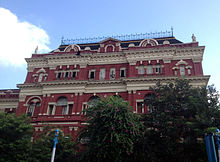

| No | Name | Image | Term(s) | Party | Governor | Viceroy |
|---|---|---|---|---|---|---|
| 1 | Sher-e-Bangla A. K. Fazlul Huq |
 |
1 April 1937 – 1 December 1941 12 December 1941 – 29 March 1943 |
Krishak Praja Party | Sir John Arthur Herbert | The Marquess of Linlithgow |
| 2 | Sir Khawaja Nazimuddin |  |
29 April 1943 – 31 March 1945 | Bengal Provincial Muslim League | Sir John Arthur Herbert (−1944) Sir Richard Casey (1944–) |
The Marquess of Linlithgow The Viscount Wavell |
| 3 | H. S. Suhrawardy |  |
23 April 1946 – 14 August 1947 | Bengal Provincial Muslim League | Sir Richard Casey (−1946) Sir Frederick Burrows |
The Viscount Wavell Earl Mountbatten |
Subsequently, all three Bengali chief ministers moved to East Pakistan, where they continued to be influential statesmen. Nazimuddin and Suhrawardy became Prime Ministers of Pakistan, while Huq served as the chief minister and governor of East Pakistan.
After Independence of India and Pakistan
British colonial period ended when India and Pakistan became independent nations in 1947. Bengal fell into two parts – one in India, named West Bengal and the other part in Pakistan as East Bengal, later renamed to East Pakistan in 1955.
East Bengal (1947–1955)
Governors of East Bengal (1947–1955)
| Tenure | Governor of East Bengal |
|---|---|
| 15 August 1947 – 31 March 1950 | Sir Frederick Chalmers Bourne |
| 31 March 1950 – 31 March 1953 | Sir Feroz Khan Noon |
| 31 March 1953 – 29 May 1954 | Chaudhry Khaliquzzaman |
| 29 May 1954 – May 1955 | Iskandar Ali Mirza |
| May 1955 – June 1955 | Muhammad Shahabuddin (acting) |
| June 1955 – 14 October 1955 | Amiruddin Ahmad |
Chief ministers of East Bengal (1947–1955)
| Tenure | Chief Minister of East Bengal | Political Party |
|---|---|---|
| August 1947 – September 1948 | Sir Khwaja Nazimuddin | Muslim League |
| September 1948 – April 1954 | Nurul Amin | Muslim League |
| April 1954 – 1955 | Abul Kasem Fazlul Huq | United Front |
East Pakistan (1955–1971)
Governors of East Pakistan (1955–1971)
In late 1955, the prime minister Muhammad Ali Bogra initiated the One Unit policy which resulted in East Bengal province being renamed to East Pakistan.
| Tenure | Governor of East Pakistan | Political Affiliation |
|---|---|---|
| 14 October 1955 – March 1956 | Amiruddin Ahmad | Muslim League |
| March 1956 – 13 April 1958 | A. K. Fazlul Huq | Muslim League |
| 13 April 1958 – 3 May 1958 | Hamid Ali (acting) | Awami League |
| 3 May 1958 – 10 October 1958 | Sultanuddin Ahmad | Awami League |
| 10 October 1958 – 11 April 1960 | Zakir Husain | Muslim League |
| 11 April 1960 – 11 May 1962 | Lieutenant-General Azam Khan, PA | Military Administration |
| 11 May 1962 – 25 October 1962 | Ghulam Faruque | Independent |
| 25 October 1962 – 23 March 1969 | Abdul Monem Khan | Civil Administration |
| 23 March 1969 – 25 March 1969 | Mirza Nurul Huda | Civil Administration |
| 25 March 1969 – 23 August 1969 | Major-General Muzaffaruddin, PA | Military Administration |
| 23 August 1969 – 1 September 1969 | Lieutenant-General Sahabzada Yaqub Khan, PA | Military Administration |
| 1 September 1969 – 7 March 1971 | Vice-Admiral Syed Mohammad Ahsan, PN | Military Administration |
| 7 March 1971 – 6 April 1971 | Lieutenant-General Sahabzada Yaqub Khan, PA | Military Administration |
| 6 April 1971 – 31 August 1971 | Lieutenant-General Tikka Khan, PA | Military Administration |
| 31 August 1971 – 14 December 1971 | Abdul Motaleb Malik | Independent |
| 14 December 1971 – 16 December 1971 | Lieutenant-General Amir Abdullah Khan Niazi, PA | Military Administration |
Chief ministers of East Pakistan (1955–1971)
| Tenure | Chief Minister of East Pakistan | Political Party |
|---|---|---|
| August 1955 – September 1956 | Abu Hussain Sarkar | Krishan Sramik Party |
| September 1956 – March 1958 | Ataur Rahman Khan | Awami League |
| March 1958 | Abu Hussain Sarkar | Krishan Sramik Party |
| March 1958 – 18 June 1958 | Ataur Rahman Khan | Awami League |
| 18 June 1958 – 22 June 1958 | Abu Hussain Sarkar | Krishan Sramik Party |
| 22 June 1958 – 25 August 1958 | Governor's Rule | |
| 25 August 1958 – 7 October 1958 | Ataur Rahman Khan | Awami League |
On 7 October 1958, the post of Chief Minister of East Pakistan was abolished. And after the independence of Bangladesh on 16 December 1971, the province of East Pakistan was dissolved.
West Bengal (1947–present)
Governors of West Bengal
| No. | Portrait | Name | Took office | Left office | Duration |
|---|---|---|---|---|---|
| 1 | 
|
Chakravarthi Rajagopalachari | 15 August 1947 | 21 June 1948 | 311 days |
| 2 | 
|
Kailash Nath Katju | 21 June 1948 | 1 November 1951 | 3 years, 133 days |
| 3 | 
|
Harendra Coomar Mookerjee | 1 November 1951 | 8 August 1956 | 4 years, 281 days |
| – | – | Phani Bhusan Chakravartti (acting) | 8 August 1956 | 3 November 1956 | 87 days |
| 4 | – | Padmaja Naidu | 3 November 1956 | 1 June 1967 | 10 years, 210 days |
| 5 | 
|
Dharma Vira | 1 June 1967 | 1 April 1969 | 1 year, 304 days |
| – | – | Deep Narayan Sinha (acting) | 1 April 1969 | 19 September 1969 | 171 days |
| 6 | – | Shanti Swaroop Dhavan | 19 September 1969 | 21 August 1971 | 1 year, 336 days |
| 7 | Anthony Lancelot Dias | 21 August 1971 | 6 November 1979 | 8 years, 77 days | |
| 8 | – | Tribhuvana Narayana Singh | 6 November 1979 | 12 September 1981 | 1 year, 310 days |
| 9 | – | Bhairab Dutt Pande | 12 September 1981 | 10 October 1983 | 2 years, 28 days |
| 10 | 
|
Anant Prasad Sharma | 10 October 1983 | 16 August 1984 | 320 days |
| — | – | Satish Chandra (acting) | 16 August 1984 | 1 October 1984 | 46 days |
| 11 | 
|
Uma Shankar Dikshit | 1 October 1984 | 12 August 1986 | 1 year, 315 days |
| 12 | 
|
Saiyid Nurul Hasan | 12 August 1986 | 20 March 1989 | 2 years, 220 days |
| 13 | 
|
T. V. Rajeswar | 20 March 1989 | 7 February 1990 | 324 days |
| (12) | 
|
Saiyid Nurul Hasan | 7 February 1990 | 12 July 1993 | 3 years, 155 days |
| – | – | B. Satyanarayan Reddy (additional charge) | 13 July 1993 | 14 August 1993 | 32 days |
| 14 | 
|
K. V. Raghunatha Reddy | 14 August 1993 | 27 April 1998 | 4 years, 256 days |
| 15 | 
|
Akhlaqur Rahman Kidwai | 27 April 1998 | 18 May 1999 | 1 year, 21 days |
| 16 | 
|
Shyamal Kumar Sen | 18 May 1999 | 4 December 1999 | 200 days |
| 17 | 
|
Viren J. Shah | 4 December 1999 | 14 December 2004 | 5 years, 10 days |
| 18 | 
|
Gopalkrishna Gandhi | 14 December 2004 | 14 December 2009 | 5 years, 0 days |
| – | 
|
Devanand Konwar (additional charge) | 14 December 2009 | 23 January 2010 | 40 days |
| 19 | 
|
M.K. Narayanan | 24 January 2010 | 30 June 2014 | 4 years, 157 days |
| — | 
|
D. Y. Patil (additional charge) | 3 July 2014 | 17 July 2014 | 14 days |
| 20 | 
|
Keshari Nath Tripathi | 24 July 2014 | 29 July 2019 | 5 years, 5 days |
| 21 | 
|
Jagdeep Dhankhar | 30 July 2019 | 17 July 2022 | 2 years, 352 days |
| — | 
|
La. Ganesan (additional charge) | 18 July 2022 | 17 November 2022 | 122 days |
| 22 | 
|
C. V. Ananda Bose | 18 November 2022 | Incumbent | 2 years, 48 days |
Prime ministers of West Bengal
| No. | Portrait | Name | Tenure | Duration | Assembly (election) |
Party | Appointed
by (Governor) | ||
|---|---|---|---|---|---|---|---|---|---|
| 1 | 
|
Prafulla Chandra Ghosh | 15 August 1947 | 22 January 1948 | 160 days | Provincial Assembly
(1946–52) |
Indian National Congress | Chakravarthi Rajagopalachari | |
| 2 | 
|
Bidhan Chandra Roy | 23 January 1948 | 26 January 1950 | 2 years, 3 days | ||||
Chief ministers of West Bengal
| No | Portrait | Name | Constituency | Tenure | Duration | Assembly (election) |
Party (alliance) | ||
|---|---|---|---|---|---|---|---|---|---|
| (2) | 
|
Bidhan Chandra Roy |
26 January 1950 | 30 March 1952 | 12 years, 156 days (total: 14 years, 159 days) |
Provincial Assembly (1946 election) |
Indian National Congress | ||
| Bowbazar | 31 March 1952 | 5 April 1957 | 1st | ||||||
| 6 April 1957 | 2 April 1962 | 2nd | |||||||
| Chowrangee | 3 April 1962 | 1 July 1962 | 3rd (1962 election) | ||||||
| 2 |  |
Prafulla Chandra Sen | Arambagh East | 9 July 1962 | 28 February 1967 | 4 years, 234 days | |||
| 3 | 
|
Ajoy Kumar Mukherjee | Tamluk | 1 March 1967 | 21 November 1967 | 265 days | 4th | Bangla Congress (United Front) |
|
| (1) | 
|
Prafulla Chandra Ghosh | Jhargram | 21 November 1967 | 19 February 1968 | 90 days (total: 250 days) |
Independent (Progressive Democratic Front) |
||
| – | 
|
Vacant (President's rule) |
N/A | 20 February 1968 | 25 February 1969 | 1 year, 5 days | Dissolved | N/A | |
| (3) | 
|
Ajoy Kumar Mukherjee | Tamluk | 25 February 1969 | 16 March 1970 | 1 year, 19 days | 5th (1969 election) |
Bangla Congress (United Front) |
|
| – | 
|
Vacant (President's rule) |
N/A | 19 March 1970 | 30 July 1970 | 1 year, 14 days | N/A | ||
| 30 July 1970 | 2 April 1971 | Dissolved | |||||||
| (3) | 
|
Ajoy Kumar Mukherjee | Tamluk | 2 April 1971 | 28 June 1971 | 87 days (total: 2 years, 6 days) |
6th | Indian National Congress (Democratic Coalition) |
|
| – | 
|
Vacant (President's rule) |
N/A | 29 June 1971 | 20 March 1972 | 265 days | Dissolved | N/A | |
| 4 |  |
Siddhartha Shankar Ray | Maldah | 20 March 1972 | 30 April 1977 | 5 years, 41 days | 7th | Indian National Congress (Progressive Democratic Alliance) |
|
| – | 
|
Vacant (President's rule) |
N/A | 30 April 1977 | 20 June 1977 | 51 days | Dissolved | N/A | |
| 5 | 
|
Jyoti Basu | Satgachhia | 21 June 1977 | 23 May 1982 | 23 years, 137 days | 8th | Communist Party of India (Marxist) (Left Front) |
|
| 24 May 1982 | 29 March 1987 | 9th | |||||||
| 30 March 1987 | 18 June 1991 | 10th | |||||||
| 19 June 1991 | 15 May 1996 | 11th | |||||||
| 16 May 1996 | 5 November 2000 | 12th | |||||||
| 6 | 
|
Buddhadeb Bhattacharya | Jadavpur | 6 November 2000 | 14 May 2001 | 10 years, 188 days | |||
| 15 May 2001 | 17 May 2006 | 13th | |||||||
| 18 May 2006 | 13 May 2011 | 14th (2006 election) | |||||||
| 7 | 
|
Mamata Banerjee | Bhabanipur | 20 May 2011 | 25 May 2016 | 13 years, 230 days | 15th | Trinamool Congress | |
| 26 May 2016 | 4 May 2021 | 16th | |||||||
| 5 May 2021 | Incumbent | 17th | |||||||
After independence of Bangladesh
East Pakistan seceded from West Pakistan on 16 December 1971 after the end of Bangladesh Liberation War and was named Bangladesh as an independent nation.
The President was the executive Head of state of Bangladesh during Presidential system of government from 1975 to 1991. Thereafter, the Prime Minister is the executive head of government of this parliamentary republic while the President is the ceremonial Head of state, elected by the parliament.
Presidents of Bangladesh
- Political parties
- Other factions
- Status
- Symbols
| No. | Portrait | Name (Birth–Death) |
Election | Term of office | Political party (Coalition) | ||
|---|---|---|---|---|---|---|---|
| Took office | Left office | Time in office | |||||
| Provisional Government of Bangladesh (1971–1972) | |||||||
| 1 | 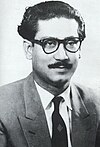
|
Sheikh Mujibur Rahman (1920–1975) |
— | 17 April 1971 | 12 January 1972 | 270 days | AL |
| — | 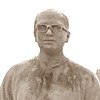
|
Syed Nazrul Islam (1925–1975) |
— | 17 April 1971 | 12 January 1972 | 270 days | AL |
| People's Republic of Bangladesh (1972–present) | |||||||
| 2 | 
|
Abu Sayeed Chowdhury (1921–1987) |
— | 12 January 1972 | 24 December 1973 | 1 year, 346 days | AL |
| 3 | 
|
Mohammad Mohammadullah (1921–1999) |
— | 24 December 1973 | 27 January 1974 | 1 year, 32 days | AL |
| 1974 | 27 January 1974 | 25 January 1975 | |||||
| (1) | 
|
Sheikh Mujibur Rahman (1920–1975) |
— | 25 January 1975 | 15 August 1975 (Assassinated in a coup) |
202 days | BaKSAL |
| 4 | 
|
Khondaker Mostaq Ahmad (1918–1996) |
— | 15 August 1975 | 6 November 1975 (Deposed in a coup) |
83 days | AL |
| 5 | 
|
Abu Sadat Mohammad Sayem (1916–1997) |
— | 6 November 1975 | 21 April 1977 | 1 year, 166 days | AL |
| 6 | 
|
Ziaur Rahman (1936–1981) |
1977 1978 |
21 April 1977 | 30 May 1981 (Assassinated) |
4 years, 39 days | Military / Jagodal / BNP |
| 7 | 
|
Abdus Sattar (1906–1985) |
— | 30 May 1981 | 20 November 1981 | 298 days | BNP |
| 1981 | 20 November 1981 | 24 March 1982 (Deposed in a coup) | |||||
| Post vacant (24 – 27 March 1982) | |||||||
| 8 | Ahsanuddin Chowdhury (1915–2001) |
— | 27 March 1982 | 10 December 1983 | 1 year, 258 days | Independent | |
| 9 | 
|
Hussain Muhammad Ershad (1930–2019) |
1985 1986 |
11 December 1983 | 6 December 1990 | 6 years, 360 days | Military / Janadal / JP(E) |
| — | 
|
Shahabuddin Ahmed (1930–2022) |
— | 6 December 1990 | 10 October 1991 | 308 days | Independent |
| 10 | 
|
Abdur Rahman Biswas (1926–2017) |
1991 | 10 October 1991 | 9 October 1996 | 4 years, 365 days | BNP |
| 11 | 
|
Shahabuddin Ahmed (1930–2022) |
1996 | 9 October 1996 | 14 November 2001 | 5 years, 36 days | Independent |
| 12 | 
|
Badruddoza Chowdhury (born 1930) |
2001 | 14 November 2001 | 21 June 2002 | 219 days | BNP |
| — | 
|
Muhammad Jamiruddin Sircar (born 1931) |
— | 21 June 2002 | 6 September 2002 | 77 days | BNP |
| 13 | 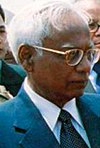
|
Iajuddin Ahmed (1931–2012) |
2002 | 6 September 2002 | 12 February 2009 | 6 years, 159 days | Independent |
| 14 | 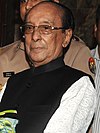
|
Zillur Rahman (1929–2013) |
2009 | 12 February 2009 | 20 March 2013 | 4 years, 36 days | AL |
| 15 | 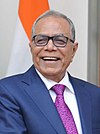
|
Mohammad Abdul Hamid (born 1944) |
— | 14 March 2013 | 24 April 2013 | 10 years, 41 days | AL |
| 2013 | 24 April 2013 | 24 April 2018 | |||||
| 2018 | 24 April 2018 | 24 April 2023 | |||||
| 16 | 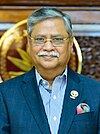
|
Mohammed Shahabuddin (born 1949) |
2023 | 24 April 2023 | Incumbent | 1 year, 256 days | AL |
Vice presidents of Bangladesh (1975–1991)
- Political parties
- Other factions
| Portrait | Name (Birth–Death) |
Took office | Party | President | Notes | ||
|---|---|---|---|---|---|---|---|
| Took office | Left office | ||||||

|
Syed Nazrul Islam (1925–1975) |
17 April 1971 | 12 January 1972 | Bangladesh Awami League | Sheikh Mujibur Rahman | Acting president during the Bangladesh Liberation War. | |
| 26 January 1975 | 15 August 1975 | BAKSAL | |||||
| Mohammad Mohammadullah (1921–1999) |
15 August 1975 | 3 November 1975 | Bangladesh Awami League | Khondaker Mostaq Ahmad | Served as Minister of Land under President Sheikh Mujib and was later appointed Vice President upon Mujib's death. | ||

|
Abdus Sattar (1906–1985) |
June 1977 | 30 May 1981 | Bangladesh Nationalist Party | Ziaur Rahman | Succeeded Zia as president in 1981. | |

|
Mirza Nurul Huda (1919–1991) |
24 November 1981 | 23 March 1982 | Independent | Abdus Sattar | Resigned after conflict with BNP. | |

|
Mohammad Mohammadullah (1921–1999) |
23 March 1982 | 24 March 1982 | Bangladesh Nationalist Party | In office for 24 hours; deposed in the 1982 coup d'état | ||

|
A. K. M. Nurul Islam (1919–2015) |
30 November 1986 | September 1989 | Jatiya Party | Hussain Muhammad Ershad | Former Supreme Court Justice and Law Minister. | |

|
Moudud Ahmed (1940–2021) |
September 1989 | December 1990 | Jatiya Party | Former Prime Minister and Deputy Prime Minister. | ||
Prime Ministers of Bangladesh
Note that numbering for Prime Minister is given either bracketless, or with ( ) brackets. Numbering for Chief Adviser is given in brackets. Acting Prime Ministers or Chief Advisers are not numbered and instead denoted as "—". There are 10 Prime Ministers, 1 Acting Prime Minister, 5 Chief Advisers, and 1 Acting Chief Adviser of Bangladesh so far.
- Political parties
- Status
- Symbols
| No. | Portrait | Name (Birth–Death) |
Election | Term of office | Political party (Coalition) | ||
|---|---|---|---|---|---|---|---|
| Took office | Left office | Time in office | |||||
| Provisional Government of Bangladesh (1971–1972) | |||||||
| 1 | Tajuddin Ahmad (1925–1975) |
— | 17 April 1971 | 12 January 1972 | 270 days | AL | |
| People's Republic of Bangladesh (1972–present) | |||||||
| 2 | 
|
Sheikh Mujibur Rahman (1920–1975) |
1973 | 12 January 1972 | 25 January 1975 | 3 years, 13 days | AL |
| 3 | 
|
Muhammad Mansur Ali (1917–1975) |
— | 25 January 1975 | 15 August 1975 (Deposed in a coup) |
202 days | BaKSAL |
| Post abolished (15 August 1975 – 29 June 1978) | |||||||
| — | Mashiur Rahman (1924–1979) Acting Prime Minister |
— | 29 June 1978 | 12 March 1979 | 256 days | BNP | |
| Post vacant (12 March – 15 April 1979) | |||||||
| 4 | 
|
Shah Azizur Rahman (1925–1988) |
1979 | 15 April 1979 | 24 March 1982 (Deposed in a coup) |
2 years, 343 days | BNP |
| Post abolished (24 March 1982 – 30 March 1984) | |||||||
| 5 | Ataur Rahman Khan (1905–1991) |
— | 30 March 1984 | 9 July 1986 | 2 years, 101 days | Janadal / JP(E) | |
| 6 | 
|
Mizanur Rahman Chowdhury (1928–2006) |
1986 | 9 July 1986 | 27 March 1988 | 1 year, 262 days | JP(E) |
| 7 | 
|
Moudud Ahmed (1940–2021) |
1988 | 27 March 1988 | 12 August 1989 | 1 year, 138 days | JP(E) |
| 8 | 
|
Kazi Zafar Ahmed (1939–2015) |
— | 12 August 1989 | 6 December 1990 | 1 year, 116 days | JP(E) |
| Post abolished (6 December 1990 – 20 March 1991) | |||||||
| 9 | 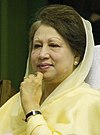
|
Khaleda Zia (born 1945) |
1991 1996 (Feb) |
20 March 1991 | 30 March 1996 | 5 years, 10 days | BNP |

|
Muhammad Habibur Rahman (1928–2014) Chief Adviser |
— | 30 March 1996 | 23 June 1996 | 85 days | Independent | |
| 10 | 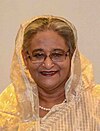
|
Sheikh Hasina (born 1947) |
1996 (Jun) | 23 June 1996 | 15 July 2001 | 5 years, 22 days | AL |
| Latifur Rahman (1936–2017) Chief Adviser |
— | 15 July 2001 | 10 October 2001 | 87 days | Independent | ||
| (9) | 
|
Khaleda Zia (born 1945) |
2001 | 10 October 2001 | 29 October 2006 | 5 years, 19 days | BNP (Four Party Alliance) |

|
Iajuddin Ahmed (1931–2012) Chief Adviser |
— | 29 October 2006 | 11 January 2007 | 74 days | Independent | |

|
Fazlul Haque (born 1938) Acting Chief Adviser |
— | 11 January 2007 | 12 January 2007 | 1 day | Independent | |
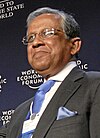
|
Fakhruddin Ahmed (born 1940) Chief Adviser |
— | 12 January 2007 | 6 January 2009 | 1 year, 360 days | Independent (with military support) | |
| (10) | 
|
Sheikh Hasina (born 1947) |
2008 2014 2018 2024 |
6 January 2009 | 5 August 2024 (Resigned) |
15 years, 212 days | AL (Grand Alliance) |
| Post vacant (5 – 8 August 2024) | |||||||

|
Muhammad Yunus (born 1940) Chief Adviser |
— | 8 August 2024 | Incumbent | 150 days | Independent | |
See also
Notes
- This refers to the 90-member rump legislature that emerged following partition, representing the West Bengali constituencies of the erstwhile Bengal Legislative Assembly. It was constituted under the Government of India Act 1935, not the Indian Constitution, which was still in the process of being drafted.
- A number in parentheses indicates that the incumbent has previously held office.
- While the tenures have been primarily sourced to a list on the West Bengal Legislative Assembly website, obvious errors (mainly around the 1969–71 period) have been corrected with the help of a historical essay from the same website.
- Until March 1952, Roy did not represent any constituency. For his last three months in office, during the Third Assembly, Roy represented Chowringhee constituency.
- Following the promulgation of the Constitution of India, the provincial assembly carried on as the legislative assembly of West Bengal until fresh elections could be organised in 1952.
- According to some sources, Sen also acted as interim chief minister during 2–8 July 1962.
- ^ Under Article 356 of the Constitution of India, President's rule may be imposed when the "government in a state is not able to function as per the Constitution", which often happens because no party or coalition has a majority in the assembly. When President's rule is in force in a state, its council of ministers stands dissolved. The office of chief minister thus lies vacant, and the administration is taken over by the governor, who functions on behalf of the central government. At times, the legislative assembly also stands dissolved.
- For the first 16 months Mamata Banerjee headed a coalition government that included ministers from Trinamool and the INC. After Trinamool quit the United Progressive Alliance in 22 September 2012, INC members resigned from her ministry, which has consisted of only Trinamool members ever since.
- Pakistani prisoner to 8 January 1972.
- Acting for Sheikh Mujibur Rahman.
- Also Chief Martial Law Administrator (24 August 1975 – 4 November 1975 and 7 November 1975 – 29 November 1976).
- Also Chief Martial Law Administrator (29 November 1976 – 6 April 1979).
- ^ Referendum.
- ^ Direct election.
- During this period, Chief of Army Staff Lt. Gen. Hussain Muhammad Ershad served as Chief Martial Law Administrator and de facto head of state.
- Served as Chief Martial Law Administrator until 30 March 1984.
- Acting for Zillur Rahman until 20 March 2013.
- Term ends on 24 April 2028.
- Senior Minister.
- Simultaneously served as President.
References
- "Gangaridai". Banglapedia. Archived from the original on 28 February 2022. Retrieved 28 February 2022.
- Majumdar, R. C. (1973). History of Mediaeval Bengal. Calcutta: G. Bharadwaj & Co. pp. 1–2. OCLC 1031074.
Tradition gives him credit for the conquest of Bengal but as a matter of fact he could not subjugate the greater part of Bengal ... All that Bakhtyār can justly take credit for is that by his conquest of Western and a part of Northern Bengal he laid the foundation of the Muslim State in Bengal. The historians of the 13th century never attributed the conquest of the whole of Bengal to Bakhtyār.
- Arnold, Thomas Walker (1913) . The Preaching of Islam: A History of the Propagation of the Muslim Faith (2nd ed.). London: Constable & Company. p. 227.
- Sen, Sailendra (2013). A Textbook of Medieval Indian History. Primus Books. pp. 68–102. ISBN 978-9-38060-734-4.
- Nanda, J. N (2005). Bengal: the unique state. Concept Publishing Company. p. 10. 2005. ISBN 978-81-8069-149-2.
Bengal was rich in the production and export of grain, salt, fruit, liquors and wines, precious metals, and ornaments besides the output of its handlooms in silk and cotton. Europe referred to Bengal as the richest country to trade with.
- "The Mahabharata of Krishna-Dwaipayana Vyasa" Translated into English Prose, Bharata Press, Calcutta (1883–1896)
- Digha Nikaya
- The Garuda Purana 55.12; V.D. I.9.4; the Markendeya Purana 56.16–18
- "West Bengal | History, Culture, Map, Capital, & Population | Britannica". Archived from the original on 17 April 2021. Retrieved 17 April 2021.
- >Hossain, Md. Mosharraf (2006). Mahasthan: Anecdote to History. Dibyaprakash. pp. 69, 73. ISBN 984-483-245-4.
- Ghosh, Suchandra. "Pundravardhana". Banglapedia. Asiatic Society of Bangladesh. Archived from the original on 23 June 2017. Retrieved 10 November 2007.
- Klidsa; Mallinatha. Sajvan; Kle, M. R. (Moreshvar Ramchandra) (1922). The Raghuvamsa of Kalidasa : with the commentary (the Samjivani) of Mallinatha ; Cantos I-X ; edited with a literal English translation, copious notes in Sanskrit and English, and various readings &c. &c. by M.R. Kale. Robarts - University of Toronto. Bombay : P.S. Rege.
- Jha, M. (1997). "Hindu Kingdoms at contextual level". Anthropology of Ancient Hindu Kingdoms: A Study in Civilizational Perspective. New Delhi: M.D. Publications Pvt. Ltd. pp. 27–42. ISBN 9788175330344.
- Kamal Kant Jha; Pt. Sri ganeshrai Vidyabhushan; Dhanakar Thakur. "A Brief History of Mithila State Bihar Articles". Archived from the original on 1 March 2012. Retrieved 10 January 2008.
- Encyclopaedia of Hinduism. Nagendra Kumar Singh, p. 3239.
- Raychaudhuri, Hemchandra (1972), Political History of Ancient India, University of Calcutta, Calcutta, pp. 106–113, 186–90
- "History". Banglapedia. Archived from the original on 29 September 2017. Retrieved 23 September 2017.
Shah-i-Bangalah, Shah-i-Bangaliyan and Sultan-i-Bangalah
- Wicks, Robert S. (1995). Money, Markets, and Trade in Early Southeast Asia: The Development of Indigenous Monetary Systems to AD 1400. Cornell University Press. p. 87. ISBN 978-1-5017-1947-9. Archived from the original on 25 December 2023. Retrieved 12 October 2021.
- Johnston, E. H. (1944). "Some Sanskrit Inscriptions of Arakan". Bulletin of the School of Oriental and African Studies, University of London. 11 (2): 357–385. doi:10.1017/S0041977X00072529. ISSN 0041-977X. JSTOR 609320. S2CID 191758063.
- Laloo, Betty (20 July 2016). "III: Early Jaintia State Formation" (PDF). Reconstructing the early Jaintia state through oral traditions (PhD). North-Eastern Hill University. Archived (PDF) from the original on 25 December 2023. Retrieved 13 October 2021.
- "Jaintia Hills-Land of Myths and Legends". Mesmerizing Meghalaya. Archived from the original on 12 August 2020.
- Dasgupta, Biswas & Mallik 2009, p. 31-43.
- Mallik, Abhaya Pada (1921). History of Bishnupur-Raj: An Ancient Kingdom of West Bengal. Abhaya Pada Mallik. pp. 128–130. Archived from the original on 25 December 2023. Retrieved 11 March 2016.
- ^ Dilip Kumar Ganguly (1994). Ancient India, History and Archaeology. Abhinav. pp. 33–41. ISBN 978-81-7017-304-5. Archived from the original on 2 February 2023. Retrieved 26 May 2022.
- Susan L. Huntington (1984). The "Påala-Sena" Schools of Sculpture. Brill Archive. pp. 32–39. ISBN 90-04-06856-2. Archived from the original on 25 December 2023. Retrieved 26 May 2022.
- R. C. Majumdar (1971). History of Ancient Bengal. G. Bharadwaj. pp. 161–162.
- Abdul Momin Chowdhury (1967). Dynastic history of Bengal, c. 750-1200 CE. Asiatic Society of Pakistan. pp. 272–273.
- Bindeshwari Prasad Sinha (1977). Dynastic History of Magadha, Cir. 450–1200 A.D. Abhinav Publications. pp. 253–. ISBN 978-81-7017-059-4. Archived from the original on 27 May 2022. Retrieved 26 May 2022.
- Dineshchandra Sircar (1975–1976). "Indological Notes - R.C. Majumdar's Chronology of the Pala Kings". Journal of Ancient Indian History. IX: 209–10.
- Ahmed, ABM Shamsuddin (2012). "Iltutmish". In Islam, Sirajul; Jamal, Ahmed A. (eds.). Banglapedia: National Encyclopedia of Bangladesh (Second ed.). Asiatic Society of Bangladesh. Archived from the original on 3 July 2015. Retrieved 26 October 2015.
- Encyclopedia Of Bangladesh (Set Of 30 Vols.) By Nagendra Kr. Singh
- Sirajul Islam; Miah, Sajahan; Khanam, Mahfuza; Ahmed, Sabbir, eds. (2012). "Mahabbat Khan". Banglapedia: the National Encyclopedia of Bangladesh (Online ed.). Dhaka, Bangladesh: Banglapedia Trust, Asiatic Society of Bangladesh. ISBN 984-32-0576-6. OCLC 52727562. OL 30677644M. Retrieved 5 January 2025.
- Karim, Abdul (2012). "Muhammad Azam, Prince". In Islam, Sirajul; Jamal, Ahmed A. (eds.). Banglapedia: National Encyclopedia of Bangladesh (Second ed.). Asiatic Society of Bangladesh. Archived from the original on 13 January 2016. Retrieved 26 October 2015.
- "Princess Daisy of Pless: The Happy Years. An exhibition at Castle Pless". www.rvondeh.dircon.co.uk. Archived from the original on 25 April 2009. Retrieved 13 October 2021.
- Rāẏa, Suprakāśa (1999). Peasant Revolts And Democratic Struggles In India. ICBS (Delhi). p. 24. ISBN 978-81-85971-61-2. Retrieved 29 October 2015.
- Sharma, Virendra Nath (1995), Sawai Jai Singh and His Astronomy, Motilal Banarsidass Publ., pp. 8–9, ISBN 978-81-208-1256-7
- Cite error: The named reference
blpwas invoked but never defined (see the help page). - Paul, Gautam. "Murshidabad History – Hassan Ali". murshidabad.net. Archived from the original on 1 September 2016. Retrieved 9 October 2016.
- East India Company (1807). Papers Presented to the House of Commons Concerning the Late Nabob of the Carnatic. p. 118. Archived from the original on 20 October 2022. Retrieved 24 September 2021.
- Paul, Gautam. "Murshidabad History – Waresh Ali". murshidabad.net. Archived from the original on 22 March 2017. Retrieved 9 October 2016.
- ^ Mahato, Sukumar (20 August 2014). "Murshidabad gets a Nawab again, but fight for assets ahead". The Times of India. Archived from the original on 26 April 2015. Retrieved 14 June 2015.
- ^ "Portrait of an accidental Nawab". The Times of India. 22 August 2014. Archived from the original on 23 August 2014. Retrieved 14 June 2015.
- "Premier of Bengal". West Bengal Legislative Assembly. Archived from the original on 14 July 2014.
- (acting martial law administrator and governor as he was the GOC 14th Infantry Division)
- "Dr D Y Patil appointed West Bengal's acting Governor". The Economic Times. 3 July 2014. Retrieved 24 December 2019.
- "Senior Advocate Jagdeep Dhankhar Made West Bengal Governor". www.livelaw.in. 20 July 2019. Retrieved 24 December 2019.
- ^ Premiers/Chief Ministers of West Bengal. West Bengal Legislative Assembly. Archive link from 12 March 2016.
- ^ The Legislature in West Bengal—Its Origin and Growth. West Bengal Legislative Assembly. Retrieved on 14 August 2024.
- Brief Information on Previous Assemblies. West Bengal Legislative Assembly. Archive link from 12 March 2016.
- List of Chief Ministers of West Bengal. Panchayat & Rural Development Department, Hooghly. Retrieved on 27 July 2018. Archived on 27 July 2018.
- Amberish K. Diwanji. "A dummy's guide to President's rule". Rediff.com. 15 March 2005. Archived on 16 August 2017.
- "Six Congress ministers resign from Mamata government in Bengal". 22 September 2012.
- Schottli, Jivanta; Mitra, Subrata K.; Wolf, Siegried (2015). A Political and Economic Dictionary of South Asia. Routledge. ISBN 978-1-135-35576-0. Retrieved 6 November 2015.
- ^ ১৯৭১ সাল থেকে ০৭-০১-২০১৯ গণপ্রজাতন্ত্রী বাংলাদেশের রাষ্ট্রপতি, উপ-রাষ্ট্রপতি, প্রধানমন্ত্রী ও মন্ত্রিপরিষদের সদস্যবৃন্দ. Cabinet Division. Retrieved 12 August 2024.
- Schottli, Jivanta; Mitra, Subrata K.; Wolf, Siegried (2015). A Political and Economic Dictionary of South Asia. Routledge. ISBN 978-1-135-35576-0. Retrieved 6 November 2015.
- Kolbert, Elizabeth (6 October 1985). "Abdus Sattar, Ex-Leader of Bangladesh, Dies". The New York Times. Bangladesh. Retrieved 6 November 2015.
- Ahmed, Salahuddin (2004). Bangladesh: Past and Present. APH. ISBN 978-81-7648-469-5. Retrieved 6 November 2015.
- "Mohammadullah, Mohammad". Banglapedia. Retrieved 6 November 2015.
- "Vice President Named By Bangladesh Leader". The New York Times. Bangladesh. Reuters. 1 December 1986. Retrieved 6 November 2015.
- "A look back at caretaker governments throughout the years". The Business Standard. 8 August 2024.
Sources
- Dasgupta, Gautam Kumar; Biswas, Samira; Mallik, Rabiranjan (2009). Heritage Tourism: An Anthropological Journey to Bishnupur. A Mittal Publication. p. 21. ISBN 978-8183242943.
- Sirajul Islam; Miah, Sajahan; Khanam, Mahfuza; Ahmed, Sabbir, eds. (2012). "Subahdar". Banglapedia: the National Encyclopedia of Bangladesh (Online ed.). Dhaka, Bangladesh: Banglapedia Trust, Asiatic Society of Bangladesh. ISBN 984-32-0576-6. OCLC 52727562. OL 30677644M. Retrieved 5 January 2025.
- Barpujari, H. K., ed. (1990). The Comprehensive History of Assam: From the Pre-historic Times to the Twelfth Century A.D. Vol. 1. Guwahati: Publication Board, Assam.
| Bangladesh articles | |||||||||||||||
|---|---|---|---|---|---|---|---|---|---|---|---|---|---|---|---|
| History |
| ||||||||||||||
| Geography | |||||||||||||||
| Politics |
| ||||||||||||||
| Economy |
| ||||||||||||||
| Society |
| ||||||||||||||